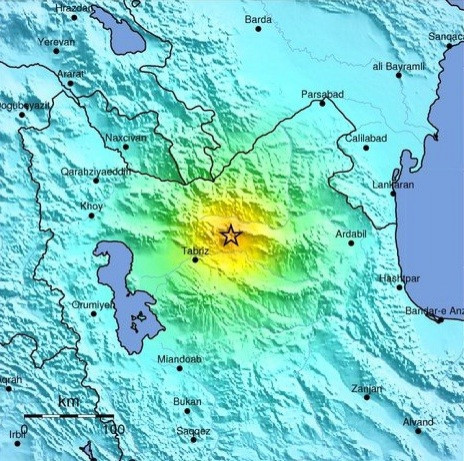Iran: Land Of Dangerous And Frequent Earthquakes

The earthquake over the weekend in northwestern Iran that has killed more than 300 people and injured 5,000 others is but the latest such disaster in one of the world’s most seismically active parts of the world.
On Saturday, a quake of magnitude 6.4 struck about 37 miles northeast of the city of Tabriz, according to the U.S. Geological Survey, or USGS. A second tremor, of magnitude 6.3, hit shortly thereafter near the town of Varzaghan, 30 miles northeast of Tabriz.
All told, about 1,000 villages -- many of them remote and not easily accessible -- were impacted by the quakes and, in some cases, completely destroyed or severely damaged. More than 36,000 local people are now housed in emergency shelters, Reuters reported.
The locations of the quakes -- in East Azerbaijan province, which borders Azerbaijan and Armenia -- are comfortably distant from Iran’s oil-producing facilities and its known nuclear centers.
However, earthquakes are a recurring phenomenon in Iran as the country is home to major fault lines, covering 90 percent of the nation.
“The Iranian plateau, characterized by active faulting, active folding, recent volcanic activities and considerable elevation contrasts along the Alpine-Himalayan mountain belt, has been frequently struck by catastrophic earthquakes during recorded history," stated Encyclopedia Iranica. "These earthquakes have resulted in great loss of life and, by rendering large numbers of people homeless and disrupting the agricultural and industrial bases of their lives, have wasted natural resources.”
In one of the most devastating quakes of recent years, in December 2003, a magnitude 6.6 quake struck the ancient city of Bam in the southeast, killing 31,000 people.
Since 2002, Iran has been hammered by at least 11 quakes measuring a minimum 5.3 on the Richter scale.
In June 1990, a tremor in the Gilan province in the north (just to the east of the latest disaster), killed more than 40,000 people, making it the deadliest quake in Iran in the 20th century.
USGS estimates that 126,000 people have died in Iranian earthquakes over the past century.
According to historic accounts, the worst quakes ever to hit Iran (in terms of lives lost) occurred in the ninth century AD.
In the year 856, a 7.9 magnitude quake in Damghan on Iran’s north central coast killed an astonishing 200,000 people (although this figure cannot be verified by modern geologists), making it the seventh-deadliest quake in recorded history.
A generation later, another massive quake struck Ardabil in northwestern Iran, killing an estimated 150,000 people, the ninth most devastating quake in world history.
© Copyright IBTimes 2024. All rights reserved.





















